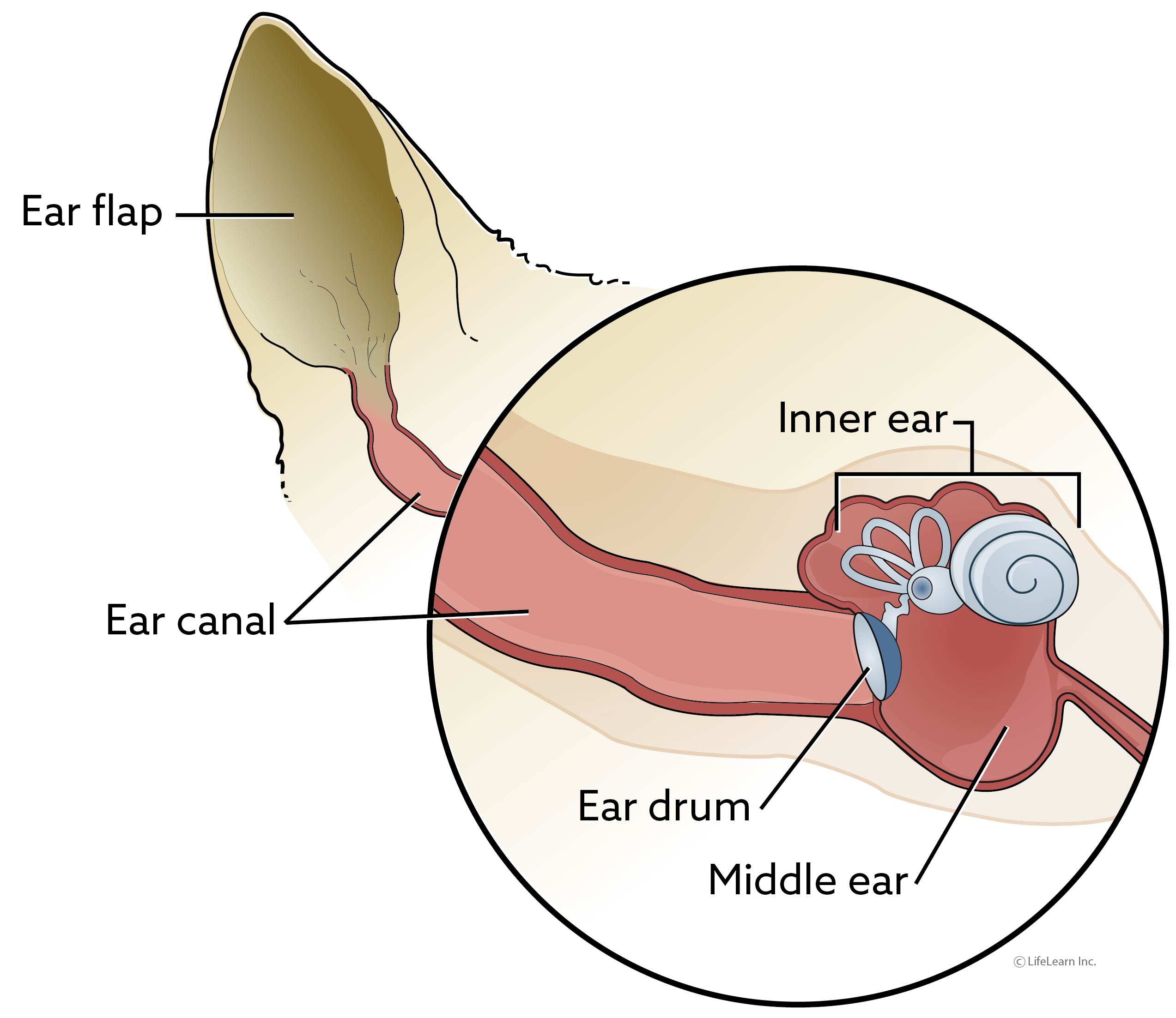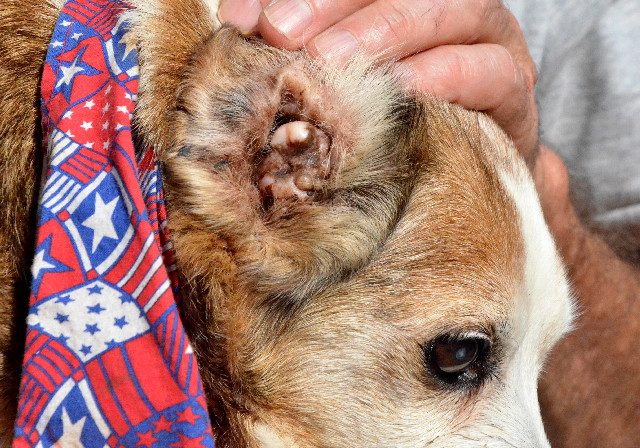Otitis Externa (Ear Infection)
What is otitis externa?
Infection of the external ear canal (outer ear infection) is called otitis externa and is one of the most common types of infections seen in dogs. Some breeds, particularly those with large, floppy or hairy ears like Cocker Spaniels, Miniature Poodles, or Old English Sheepdogs, appear to be more prone to ear infections, but ear infections may occur in any breed.
Infections of the external ear canal or outer ear caused by bacteria and yeast are common in dogs, but not as common in cats. Outer ear infections are called otitis externa. The most common cause of feline otitis externa is ear mite infestation.

What are the symptoms of an ear infection?
Ear infections are painful. Many dogs will shake their head and scratch their ears trying to relieve the discomfort. The ears often become red and inflamed and develop an offensive odor. A black or yellowish discharge commonly occurs. In chronic cases the ears may appear crusty or thickened and the ear canals often become narrowed (stenotic) due to the chronic inflammation.

Don't these symptoms usually indicate ear mites?
Ear mites can cause several of these symptoms, including a black discharge, scratching, and head shaking. However, ear mite infections are more common in puppies and kittens. Adult dogs may occasionally contract ear mites from puppies or cats that are infected. Ear mites create an environment within the ear canal that often leads to a secondary bacterial or yeast (fungal) infection.

Since these symptoms are similar and usually mean an infection, why can't I just get some ear medication?
There are several kinds of bacteria and at least one type of fungus that commonly cause ear infections. Without knowing the specific kind of infection present, it is not possible to know which medication to use. In some cases, the problem is a foreign body, a polyp, or a tumor. Treatment with medication alone will not resolve these problems. It is important that your dog be examined to ensure that the eardrum is intact. Administration of certain medications can result in loss of hearing if the eardrum is ruptured. This can only be detected by a thorough ear examination by your veterinarian.
How do you know which drug to use?
First, the ear canal is examined with an otoscope, an instrument that provides magnification and light. This examination allows your veterinarian to determine whether the eardrum is intact and if there is any foreign material in the canal. When a dog is in extreme pain and refuses to allow the examination, it may be necessary to sedate or anesthetize the dog for a thorough examination.
The next step is to examine a sample of the material from the ear canal under a microscope to determine the type of organism causing the infection. Microscopic examination is important in helping your veterinarian choose the right medication to treat the inflamed ear canal. Culture and susceptibility tests are often used in severe or chronic ear infections to ensure your pet is receiving the right medication.
How are ear infections treated?
The results of the otoscopic and microscopic examination usually determine the diagnosis and course of treatment. If there is a foreign body, wax plug, or parasite lodged in the ear canal, it will be removed. Some dogs must be sedated for this, or to allow a thorough ear flushing and cleaning. Many dogs will have more than one type of infection present (e.g., a bacterium and a fungus, or two kinds of bacteria). This situation usually requires the use of multiple medications or a broad-spectrum medication.
An important part of the evaluation of the patient is the identification of underlying disease. Many dogs with chronic or recurrent ear infections have allergies or low thyroid function (hypothyroidism). If underlying disease is suspected, it must be diagnosed and treated or the pet will continue to experience chronic ear problems.

What is the prognosis?
Nearly all ear infections that are properly diagnosed and treated can be successfully managed. However, if an underlying cause remains unidentified and untreated, the outcome will be less favorable. Several recheck examinations may be needed before the outcome is successful.
How important is it to treat an ear infection?
Dogs with ear infections are uncomfortable. Their ears are a source of constant pain and they frequently scratch them and shake their head. This can cause a condition called an 'aural hematoma,' in which blood vessels in the ear flap break, causing a painful swelling that requires surgical treatment. Deep ear infections can damage or rupture the eardrum, causing an internal ear infection and even permanent hearing loss.
My dog's ear canal is nearly closed. Is that a problem?
Closing of the ear canal is another result of a chronic ear infection. This is known as hyperplasia or stenosis. If the ear canal is swollen, it is difficult or impossible for medications to penetrate into the horizontal canal. Anti-inflammatory medications can sometimes shrink the swollen tissues and open the canal in some dogs. Most cases of hyperplasia will eventually require surgery.
My cat's ear canal is nearly closed. Is this a problem?
Closing of the ear canal occurs when an infection becomes severe and chronic. There are medications that may help shrink the swollen tissues and open the canal in some cats. However, some cases may eventually require surgery.
The ear canal may be medicated by following these steps:
- Gently pull the earflap straight up and slightly toward the back and hold it with one hand.
- Using the other hand, apply a small amount of medication into the vertical part of the ear canal while continuing to keep the earflap elevated. Hold the ear up long enough for the medication to run down to the turn between the vertical and horizontal canal.
- Put one finger in front of and at the base of the earflap, and put your thumb behind and at the base.
- Massage the ear canal between your finger and thumb. A 'squishing' sound tells you that the medication has gone into the horizontal canal.
- Release the ear and let your dog shake its head. Many medications will contain a wax solvent and you may observe debris dissolved in this solvent leaving the ear as your pet shakes its head.
If a second medication is to be used, apply it in the same manner. Typically, you should wait 5-30 minutes before applying additional medications. Be sure to ask your veterinarian for specific directions regarding any ear medication or cleansing agents.



